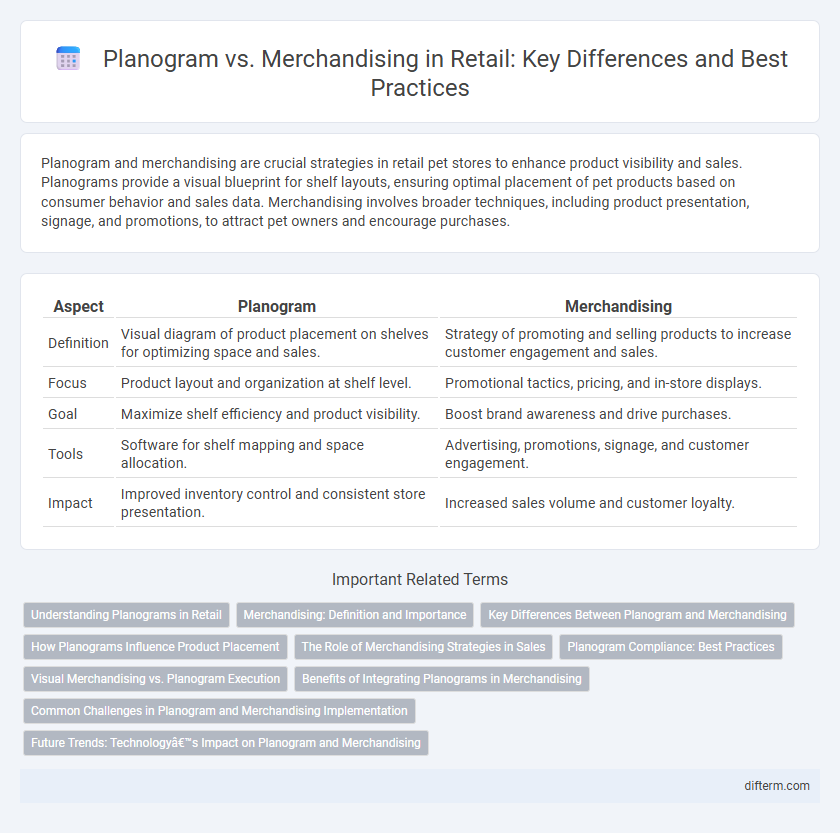Planogram and merchandising are crucial strategies in retail pet stores to enhance product visibility and sales. Planograms provide a visual blueprint for shelf layouts, ensuring optimal placement of pet products based on consumer behavior and sales data. Merchandising involves broader techniques, including product presentation, signage, and promotions, to attract pet owners and encourage purchases.
Table of Comparison
| Aspect | Planogram | Merchandising |
|---|---|---|
| Definition | Visual diagram of product placement on shelves for optimizing space and sales. | Strategy of promoting and selling products to increase customer engagement and sales. |
| Focus | Product layout and organization at shelf level. | Promotional tactics, pricing, and in-store displays. |
| Goal | Maximize shelf efficiency and product visibility. | Boost brand awareness and drive purchases. |
| Tools | Software for shelf mapping and space allocation. | Advertising, promotions, signage, and customer engagement. |
| Impact | Improved inventory control and consistent store presentation. | Increased sales volume and customer loyalty. |
Understanding Planograms in Retail
Planograms are visual tools in retail that detail product placement on shelves to maximize sales and improve customer experience. They provide precise guidelines on product assortment, shelf layout, and inventory levels to ensure consistency across store locations. Effective use of planograms enhances merchandising strategies by optimizing space utilization and driving consumer purchasing behavior.
Merchandising: Definition and Importance
Merchandising involves strategically organizing products and promotional materials to maximize sales and enhance the shopping experience within retail spaces. Effective merchandising drives consumer engagement by aligning product placement, pricing, and presentation with customer preferences and market trends. It plays a crucial role in boosting brand visibility, increasing inventory turnover, and optimizing retail profitability.
Key Differences Between Planogram and Merchandising
Planogram refers to the visual representation and spatial arrangement of products on retail shelves to maximize sales and optimize space utilization, while merchandising encompasses broader strategies including product selection, pricing, promotions, and display techniques. Planograms are data-driven tools designed to standardize product placement across multiple locations, ensuring consistency and ease of shopping. Merchandising focuses on overall customer experience, combining visual appeal with marketing tactics to boost brand engagement and profitability.
How Planograms Influence Product Placement
Planograms strategically dictate product placement by mapping optimal shelf positions based on consumer behavior data and sales analytics, enhancing visibility and accessibility. This visual merchandising tool ensures consistent brand representation and maximizes space utilization, directly impacting purchasing decisions. Retailers leveraging planograms see improved inventory turnover and increased sales through data-driven product arrangement.
The Role of Merchandising Strategies in Sales
Merchandising strategies play a crucial role in driving sales by optimizing product placement, pricing, and promotional tactics to enhance customer experience and increase purchase intent. Planograms serve as detailed visual guides that support these strategies by ensuring consistent product presentation and maximizing shelf space efficiency. Effective merchandising integrates planogram compliance with dynamic market insights to boost retail performance and profitability.
Planogram Compliance: Best Practices
Planogram compliance ensures that retail displays strictly adhere to pre-designed product layouts, optimizing shelf space and enhancing customer experience. Best practices include regular audits using mobile scanning technology, employee training focused on visual merchandising standards, and leveraging data analytics to track planogram effectiveness. Consistent planogram execution boosts sales performance by maintaining visual consistency and product accessibility across all store locations.
Visual Merchandising vs. Planogram Execution
Visual merchandising focuses on creating appealing store layouts and product displays to attract customers and enhance the shopping experience, emphasizing aesthetic appeal and brand storytelling. Planogram execution involves precisely placing products according to a detailed diagram to maximize space utilization, ensure inventory consistency, and drive sales through systematic product arrangement. Effective retail strategy integrates visual merchandising's creativity with disciplined planogram adherence for optimized store presentation and operational efficiency.
Benefits of Integrating Planograms in Merchandising
Integrating planograms in merchandising enhances product placement accuracy, leading to optimized shelf space utilization and increased sales performance. This strategic alignment fosters consistent brand representation and improves customer shopping experience by making products easier to locate. Leveraging planograms reduces inventory shrinkage and streamlines replenishment processes, boosting overall operational efficiency in retail environments.
Common Challenges in Planogram and Merchandising Implementation
Common challenges in planogram and merchandising implementation include inaccurate data on product dimensions and sales performance, leading to ineffective shelf arrangements and poor inventory management. Ensuring real-time communication between store teams and headquarters often proves difficult, resulting in inconsistent execution across multiple locations. Resistance to change from retail staff and inadequate training further hinder the successful adoption of optimized merchandising strategies.
Future Trends: Technology’s Impact on Planogram and Merchandising
Planogram and merchandising will increasingly leverage AI-driven analytics and augmented reality to optimize product placement and enhance shopper engagement. Integration of IoT devices will enable real-time inventory tracking and dynamic planogram adjustments based on consumer behavior patterns. Retailers adopting these technologies are expected to increase sales effectiveness and operational efficiency significantly.
Planogram vs Merchandising Infographic

 difterm.com
difterm.com